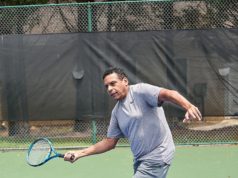According to the Cleveland Clinic, tennis elbow (a condition that usually happens because of overuse of the forearm muscles) can affect up to 50 percent of tennis players during their careers. The painful condition also can be found in up to three percent of the U.S. population, and affects more men than women, the clinic reports. Tennis elbow (also known as lateral epicondylitis) is caused by overuse and repetitive stress to the tendons and muscles around the elbow. It typically affects people who play sports with repetitive swinging motions, such as tennis or golf, but it can also affect job performance of carpenters, cooks, assembly-line workers and others. While pain is a hallmark symptom, chronic tennis elbow can cause loss of grip and arm strength, limited use of the arm, and burning sensations on the outer portion of the arm.
Typical treatments for tennis elbow include non-steroidal anti-inflammatory drugs (NSAIDS) such as ibuprofen, counter-force braces, and physical therapy. Surgery is rarely needed, but a less invasive procedure known as interventional radiology is showing promise. The treatment uses X-rays, ultrasound, and other medical images to guide small instruments such as catheters (tubes that measure just a few millimeters in diameter) through the blood vessels or other pathways. Such procedures have been used for years to treat everything from cancer to infertility.
According to recent research presented at the Society of Interventional Radiology’s 2019 Annual Scientific Meeting in Austin, Texas, tennis elbow can be treated effectively through transcatheter arterial embolization (TAE). This image-guided, non-surgical treatment decreases abnormal blood flow to the injured area to reduce inflammation and pain. “Tennis elbow can be difficult to treat, leaving many patients unable to perform the simplest tasks, such as picking up their children, cooking dinner, or even working on a computer. With this frustration, many patients turn to invasive, major surgery after years of failed physical therapy and medication use,” said Yuji Okuno, M.D., Ph.D., founder of the Okuno Clinic in Japan and lead author of the study* that was presented in Austin. “We were interested to see if this technique, already in use in other areas of the body, would be effective for this common, debilitating condition and help people immediately regain a range of motion that many of us take for granted in our everyday tasks.”
Dr. Okuno’s team conducted a prospective study in 52 patients with tennis elbow who did not find relief from other forms of treatment. The patients received TAE between March 2013 and October 2017, and were followed for up to four years after the treatment. The researchers said they found statistically significant reductions in pain-rating scores, using methods including the Quick Disability of the Arm, Shoulder and Hand scores; visual analog scale pain rating scores; Patient-rated Tennis Elbow Evaluation scores; and pain-free grip strength. Additionally, images taken in 32 of the patients just two years after undergoing TAE showed an improvement in tendinosis (a degeneration of the tendon’s collagen in response to chronic overuse) and tear scores.
This treatment for tennis elbow can be completed in approximately one hour and requires only a needle hole to access the radial artery in the wrist under local anesthesia. A catheter is moved through the wrist to the elbow where the inflamed blood vessels are embolized (blocked), preventing excessive blood flow to the affected part of the elbow. Doctors say the treatment is safe and effective, and doesn’t require physical therapy. In Okuno’s study, no adverse events were observed and no patients experienced negative effects to the surrounding bones, cartilage, or muscles.
If tennis elbow is hindering your game, perhaps this treatment will work for you. Consult with your physicians. Tell them you have ALTA plates to win!
*Abstract 25: Midterm clinical outcomes after transcatheter arterial embolization for lateral epicondylitis resistance to conservative treatment. Y. Okuno; M. Shibuya. Okuno Clinic, Tokyo, Japan. SIR Annual Scientific Meeting, March 23–28, 2019. This abstract can be found at sirmeeting.org.
About the Society of Interventional Radiology The Society of Interventional Radiology is a nonprofit, professional medical society representing more than 8,000 practicing interventional radiology physicians and other professionals. The society’s members work in a variety of settings and at different professional levels — from medical students and residents to university faculty and private-practice physicians. Visit sirweb.org for more information.




